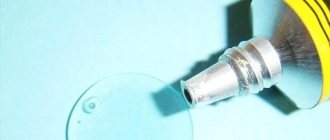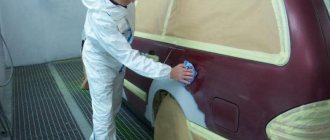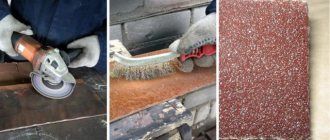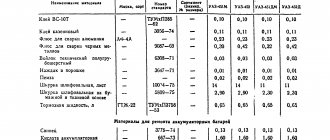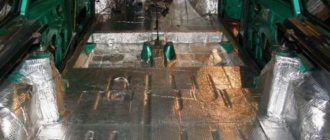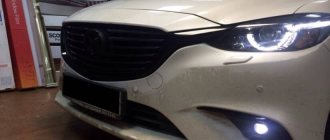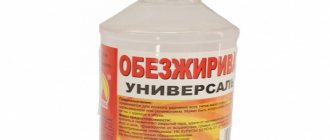From time to time there is a need to wipe off a greasy stain from the surface of the car body. In the city, this can only be done at a car wash. However, most often degreasing is required when painting a vehicle. What is it for? Thanks to this procedure, good adhesion of the body surface to the paintwork is ensured. What and how to degrease should be decided before all work begins. It is worth considering that conventional means are not always suitable for such purposes. In addition, when treating surfaces with compounds, it is necessary to take into account some nuances. So how to degrease the surface?
Why is this needed?
Before answering the question of how to degrease the surface before painting, it is worth finding out why it is needed. As a rule, metal is treated with such compounds only to ensure normal adhesion of the material from which the body is made and the paintwork. In some cases this is simply necessary. In cases where the car is completely repainted, the body must be coated with a layer of special primer. To ensure good adhesion, degreasing is still required.
Adhesion, in essence, is the bonding of one material to another. In this case, everything happens at the molecular level. If there is a layer of fat between the metal or primer and the paint coating, their adhesion will be insufficient. This can affect the appearance of the vehicle over time. Any vibration will cause the paintwork to gradually fall off.
What impairs adhesion
Car degreaser removes more than just grease. Dirt, various organic matter, oily substances of natural origin, etc. - all this reduces the adhesion of materials at the molecular level. In addition, the adhesion is affected by the oxide thin film. It looks like a slight coating of rust on the surface of the body. It is also recommended to remove this film. If it is not possible to completely remove the plaque, then you need to turn it into a stable chemical compound that does not interfere with the adhesion of the metal and the paintwork at the molecular level.
Why do you need to degrease?
The dust layer and dirty fatty films on the surface of the material prevent molecules of adhesive or paint from penetrating into the pores of the material. Paint or glue, instead of the surface of the material, connects with the molecules of the fatty layer. This significantly reduces the strength of the joint or the quality of the paintwork.
During welding, fat molecules turn into slag and reduce the quality of the weld until defects form in the welding joint.
To prevent this from happening, it is necessary to degrease the surface before starting the next operation. Degreasing is a mandatory requirement of any technology associated with gluing, painting or cooking surfaces.
Degreasing metal before painting a car
This is necessary for any materials:
A wide range of substances and methods are used to remove grease stains.
How to degrease the surface before gluing or painting
Most often, White Spirit is used to treat the body. However, many people confuse this product with regular kerosene or diesel fuel, since they have almost the same smell. The difference between these substances is very small. Both formulations are a mixture of carbohydrates. Such liquids are produced by distilling oil fractions.
Some reference books indicate that White Spirit is a light form of kerosene. It is worth noting that the product dissolves greasy, bitumen, rubber stains, as well as mastic well. Unlike kerosene, White Spirit is easier to wash off the car with plain water. Both substances are suitable for degreasing surfaces. At the same time, “White Spirit” is a light compound that partially evaporates, and the remaining part of the product does not harm the coating after painting.
Degreaser - which one is best to choose?
If you ask motorists what product they usually use to remove residual grease stains, each will name their own option. This can be either a store-bought car degreaser or one you make yourself. Some motorists try to degrease the body using gasoline, acetone, and a mixture of detergent and vinegar. But all of them poorly cope with the task or, in the worst case, can cause irreparable damage to the car’s paintwork.
People who paint cars strongly advise purchasing special industrial liquids for degreasing themselves. Today on the automotive chemicals market you can find a wide selection of different degreasers. All major manufacturers of paints and varnishes have developed proprietary degreaser compositions, and it’s up to you to decide which degreaser is best. They can be produced in various forms:
- organic solvents;
- emulsion-type compositions based on water and alkali;
- synthetics;
- lint-free wipes impregnated with solvent.
The most common means for removing grease stains is “White alcohol”. This substance is the result of oil distillation and has a specific smell of kerosene. White Spirit perfectly removes any grease stains of organic origin, bitumen and rubber stains. The disadvantages of this product include a very persistent odor and its inability to remove inorganic oil-containing deposits. Some motorists prefer to use time-tested solvents, such as acetone, kerosene, gasoline, etc. But when using these substances, it is important to remember that they all have a high degree of fire hazard and require strict adherence to certain safety measures.
If there are inorganic contaminants on the body, it is necessary to give preference to chemical compounds. Most often, motorists choose Solvent or Nefras S 2-80/120. It is better to use them when treating the car before painting.
Solvent
Also, very good results will be obtained after treating the car with universal “anti-silicones”. Antisilicone perfectly removes all types of greasy contaminants and does not have an aggressive effect on the paintwork of the car itself. This fact is especially important if we decide not to paint the body, but simply wash it well, for example, after winter, and polish it.
If it is necessary to degrease the plastic coatings of a car, “antistatic” is best suited.
Should I use kerosene?
Degreasing the surface is a simple process that can be done at home. The main thing is to choose the right product. Some professional wash stations use kerosene, as they use special equipment to process the body. This allows you to completely remove the substance from the surface without leaving its odor. If car degreasing is carried out in a garage, then for these purposes it is recommended to use White Spirit or products based on it. It is best to buy compounds that have undergone hydrotreating. It is worth paying special attention to this indicator, especially if the substance is domestically produced.
Alkaline degreasers
Alkali-based degreasing solutions are characterized by a number of advantages:
- high efficiency, including against high levels of pollution;
- low harmfulness;
- no fire hazard;
- environmental friendliness;
- various methods of application to the surface.
During interaction with alkaline solutions, saponified fatty compounds are destroyed. Unsaponifiables form an emulsion and are removed along with it. A significant disadvantage of alkaline solutions is that after treatment they must be protected against corrosion.
Surface-active substances very effectively dissolve fatty contaminants. When it comes into contact with dirty areas, foam is formed, which reduces surface tension and the adhesion force of molecules to each other. Contaminants in solid and liquid form are destroyed and turn into solutions and emulsions, which are then easy to remove. Surface degreasing products contain up to 10% surfactants.
What is not recommended to use
What can you use to degrease the surface, and what should you not use? Many do not recommend using diesel fuel, gasoline and diesel fuel. Of course, they degrease well. However, such substances can be harmful.
With caution, you should use numbered solvents, for example No. 645, No. 646, etc., as well as acetone. Such substances easily dissolve not only organic matter, dirt and grease, but also paint and varnish coatings. It is allowed to treat the body with acetone and solvents only before puttingty.
If special products are not available, then you can use a regular vinegar solution mixed with a few drops of dishwashing detergent.
What is used in the factory
In factory conditions, a sodium carbonate solution (35-50 g/l) or a sodium hydroxide solution (90-150 g/l) is used. This car degreaser should be used with extreme caution. It is recommended to wear gloves before starting work, as sodium itself is very caustic. The solution can not only remove fat from the surface of the body, but also corrode the skin on your hands.
In addition, alkaline solutions are not able to completely remove oil stains and thickened grease. Such compositions have low cleaning power. It is recommended to use alkali only after heating it to 90°C. You cannot bring it to a boil. It is worth noting that acidic solutions remove oxide film well, but do not wash away grease well. So what is the best way to degrease the surface of the body?
Trichlorethylene
In some cases, trichlorethylene or substances that contain it are used to clean the body. However, such means have their drawbacks. They cannot be applied to aluminum. In production, trichlorethylene is used only for degreasing ferrous metals.
If this substance comes into contact with aluminum, an explosion may occur. It is also not recommended to mix trichlorethylene with water, as a sticky and difficult-to-remove mass begins to form. Most often, the substance is used not in pure form, but in the form of emulsions. How to degrease the surface should be determined in advance so as not to damage the vehicle body in the future.
Cleaning in several stages
If you don’t know how and what to degrease the surface with, you can contact a specialist. In factory conditions, cleaning is carried out in several stages. In this case, degreasing occurs at the first stage. To begin with, the surface of the body is treated with White Spirit. If the metal is corroded in some places, it is recommended to clean it with a mixture of alcohol and phosphoric acid. In this case, it is worth observing the percentage ratio of substances:
- Phosphoric acid + water: 1 to 5. The solution should be from 65 to 75%.
- Isopropyl alcohol – from 13 to 18%.
- Ethyl alcohol – from 10 to 14%.
- Emulsifier OP-7 – 0.5%.
- Nitrobenzene – 0.1%.
Glass degreasers
Compared to plastics, glass practically does not react to any solvents except the strongest acids. Therefore, you can use any available composition for it. It is important to remember that the properties of glass do not apply to rubber seals - rubber or plastic frames. They will have to be dismantled or protected from the effects of the solvent composition.
To degrease the glass surface, use alcohol, acetone, license solvents, alkaline solutions, white spirit - whatever is at hand.
Recommendations
Now you know how to degrease the surface. Before purchasing special products, it is worth considering some nuances. Even when using non-hazardous compounds, it is recommended to wear gloves and a paint mask.
To carry out the degreasing procedure, you should use two napkins: one is required for applying the composition, and the second is for removing residues.
The treatment should be carried out after sanding and only before painting. Parts made of aluminum should be given special attention. After all, not all substances are safe for this metal. It is not recommended to apply the coloring composition directly to a degreased surface, since the body must warm up to room temperature.
The need to prepare metal products for painting is due to an increase in the adhesion characteristics of the substrate to the paint and varnish material and the resistance of the metal to corrosion processes. All this will have a positive effect on the service life of the painted products. However, most owners are much more concerned about the presence of rust, which must be removed during the metal preparation process, than about degreasing, which is why painting work is carried out without this important and mandatory operation.
What is defatting
The essence of the procedure is to remove fatty substances from the surface of the substrate, which are often present in cooling emulsions, mineral oils, preservative lubricants, and polishing compounds. Degreasing of the metal surface before painting also has to be done to remove residues from washing and etching, traces of sweat and fingers. All these contaminants can extremely negatively affect the quality of surface wetting with paints and varnishes, as well as harm film formation and other properties of the coating.
Depending on the amount of fatty impurities present per square meter, several degrees of surface contamination can be distinguished:
- Weak - up to 1 g;
- Medium - from 1 to 5 g;
- Increased - more than 5 g.
When processing fats with chemical reagents, several sequential processes occur on the surface:
Depending on the ability of fats to be destroyed under the influence of solvents, several types of contaminants are distinguished:
- Non-destructible - for example, emulsions.
- Pollinated - polishing materials, lubricant residues.
Chemical methods
The main type is organic solvents, which allow you to quickly remove grease and oily areas from metal parts. They are most widely used in individual production, although sometimes they are used in serial production, but not often due to their high explosion and fire hazard. The desired effect, namely the dissolution of oil and fat deposits, is achieved at the moment of contact of organic solvents with them.
The quality of surface degreasing is directly affected by the degree of solvent contamination, since the more fats are contained on the surface, the worse the chemical’s ability to dissolve existing deposits becomes. Most often, aliphatic and chlorinated solvents are used to remove fat and oil areas. Despite their high efficiency in metal cleaning, they have a serious drawback - these compounds are not able to remove abrasive materials and other mineral contaminants from the surface.
Aqueous solutions
As is known, water has poor purification ability, which is associated with significant surface tension and incompatibility with fats. Therefore, when it wets greasy surfaces, stable emulsions are not formed. To increase the cleaning properties of an aqueous solution, manufacturers resort to various techniques - increasing the pH acidity level, increasing the temperature regime of use to the range of 50-65 degrees Celsius, and introducing surfactants into the composition.
Alkaline degreasers
These compounds have a lot of positive properties. These include high cleaning ability, fire safety, environmental friendliness, and a wide selection of application methods. When treated with aqueous solutions of saponified fats and oils, the latter are inevitably destroyed, and unsaponifiable contaminants are emulsified. The latter case can be described as the process of detachment of fatty layers from the surface with gradual transformation into a working liquid and removal along with the working solution. The main disadvantage of these compositions is the need for anti-corrosion treatment of the surface after cleaning.
Among the components present in cleaning solutions, surfactants - surfactants - deal best with fatty and oily areas. Once on the surface, they form foam on it, simultaneously reducing interfacial and surface tension, increasing wettability and destroying solid and liquid contaminants, transforming them into a more convenient form for removal. The surfactant content in grease cleaners , as a rule, fluctuates within 10%.
If the need arises, along with degreasing, to remove thin oxide or hydroxide films, acidic solutions containing 1-3% phosphoric acid are used.
After treating surfaces with cleaning compounds, they must be washed with water. The presence of salt residues is unacceptable, since they can destroy the properties of paint films, increasing moisture permeability and accelerating the development of under-film corrosion.
Emulsion compositions
In cases where there is a need to remove oil deposits, grease, and difficult-to-remove contaminants from the surface, emulsion degreasing is used. This method is combined and has the advantages of organic solvents and aqueous alkaline solutions. These compositions contain emulsions of solvents and surfactants diluted with water. Chlorinated or aliphatic hydrocarbons can be used as solvents.
Ultrasonic and electrochemical methods
To increase the cleaning ability of detergent compositions, special baths with an ultrasonic field are used. This method is most relevant for small-sized products with a highly complex surface, for which it is important to remove contaminants with the highest quality possible. For large parts, it is not practical to use this method due to economic considerations, since there is a need to increase the output power of the device.
Chemical methods
The most common and easiest to use are chemical methods for degreasing surfaces.
Most often, organic solvents are used to degrease the surface. They are especially popular among home craftsmen and small workshops. Large industries try to avoid this class of products due to their high fire hazard and toxicity.
The principle of operation of organic solvents is to dissolve the contaminated layer and then remove it from the surface with a dry cloth.
The effectiveness of such products directly depends on the degree of contamination of the solvent itself - a certain volume of it can also dissolve a strictly defined amount of fatty contaminants. After reaching a certain level of contamination, the solvent is no longer able to degrease the part. Therefore, it is necessary to change wipes more often and moisten them with fresh solvent.
Organic solvents can degrease with high efficiency, but have one drawback. They cannot remove mechanical impurities, abrasive residues, etc. from the surface.
How to degrease metal before painting
In domestic conditions, owners, as a rule, use proven “old-fashioned” products - gasoline, kerosene, acetone, alcohol.
But today more modern and technologically advanced formulations are available. Among them, Nefras (White Spirit), Solvent 646 are quite popular. They have a lot of advantages - affordable price, increased level of environmental friendliness, the ability to form films that are more resistant to paintwork, which helps prevent the development of corrosion processes.
The problem for many owners is that the substrate after degreasing does not match the chosen paint. This can be avoided by purchasing a solvent suitable for the coating being treated. But more often than not, such problems do not arise when using solvent No. 646 . Consumer reviews talk about its versatility, so there is no need to carry out additional operations.
Another popular type of solvent is Antisilicone. These compounds are in high demand among craftsmen, who use them to degrease the car body before subsequent painting. However, safety rules must be observed during operation. In the room where degreasing work is carried out, windows and doors must be opened. Such solvents can be used as far as possible from sources of ignition and always wearing personal protective equipment.
The most effective are special concentrated solutions - Chistomet, Docker Dekamet and others. The main active component in these products is alkali. They also contain additional substances - inhibitors, surfactants, additives, etc. Before use, the concentrate is mixed with water in pre-calculated proportions. It all depends on the degree of contamination of the surface being treated. The advantages of these solutions are their high environmental friendliness and safety. They can be used not only to degrease the surface, but also to increase the anti-corrosion resistance of the metal. Can be used in industrial enterprises.
Aqueous solutions
Water itself is not an ideal liquid for degreasing surfaces - just remember attempts to wash greasy dishes with cold water. This is due to its high surface tension and its inability to emulsify fats.
To make surface degreasing with aqueous solutions effective, the following methods are used:
- increase pH acidity level;
- heat the solution to 55-60 o C;
- add surfactants (surfactants).
Water based degreaser
Aqueous solutions are quite effective against light and medium levels of contamination. They are significantly less dangerous to use than organic solvents.
Popular solvents
How to degrease a metal surface before painting is a pressing question for many owners. To degrease metal surfaces, today you can use not only affordable and time-tested compounds, but also modern solvents.
White spirit
Among degreasers, white spirit is most often used. It looks like a transparent, colorless liquid with a characteristic odor of fuel and lubricants.
It is sold in stores under the name “Nefras-S4” and is available in various modifications. The main reason for its popularity is due to its versatility.
This solvent can easily remove any oils and fats, as well as many organic compounds. It is often used to dilute oil paints, enamels and varnishes. White spirit also has one more positive property - after treating the surface, you do not need to wait for it to dry; you can immediately proceed to applying a primer or paint material. The solvent evaporates very quickly, and this is what gives it superiority over other cleaning compounds.
Solvent 646
This type of degreaser is widely used when preparing for painting. It is a yellowish liquid with a strong characteristic odor. It has a fairly wide range of applications.
With this composition you can not only dilute paints, but also degrease metal surfaces. It is especially effective when you need to remove old layers of paint. Can be used for washing painting equipment and tools.
Best suited for diluting the following types of enamels:
- nitrocellulose NC;
- glypthal GF;
- melaninoamide MPs;
- acrylic;
- epoxy.
When using the degreaser, it is necessary to observe the temperature recommended by the manufacturer from + 5 to + 30 degrees Celsius, while the air humidity should not be higher than 85%. Then, after treatment, the metal surface will acquire a shiny, glossy appearance without stains or streaks.
Please remember that Solvent 646 is a flammable and explosive product. You can work with it only while wearing respiratory, eye and skin protection. When carrying out work indoors, it is necessary to ensure the supply of fresh air through windows and doors or through working exhaust ventilation.
Acetone: classic
Another fairly common metal degreaser. In terms of its composition, it is a transparent liquid with a strong characteristic odor. Excellent for removing oil and grease stains, as well as tar.
Acetone can be used to dilute varnishes, enamels, paints and primers. Sometimes it is added to the composition of some solvents. The main component is alcohol, which is highly volatile.
To protect metal surfaces from corrosion processes, they must be specially treated before applying paint. Dyeing technology requires an operation such as degreasing. It can be performed using various solvents and degreasing compounds.
Among them there are both traditional and more modern and technological ones. The choice of the most suitable composition for degreasing should be made taking into account the nature and scale of the tasks at hand, as well as the purpose of the metal product.
At the same time, it is important not to forget about safety rules during degreasing work. Many formulations are unsafe due to the content of compounds harmful to health. Therefore, when carrying out work indoors, it is necessary to ensure constant access to fresh air. You also need to remember that there are no flammable sources nearby.
Any surface must be degreased before painting or carrying out other repair work. Degreasing refers to the process of removing any contaminants - dust, glue, grease, emulsions, old paint residues, and ordinary dirt. Methods and means for degreasing a surface are varied, most of them are easy to use at home.
To avoid problems
It would seem that the degreasing process is a very simple process, but even here you need to be very careful; if you select the wrong grease removal solution, you can, completely unwittingly, damage the paintwork of your car. Therefore, the choice of liquid should be made as responsibly as possible and carefully read the instructions and recommendations of the manufacturers.
If the goal is to simply polish the car, then poorly done grease removal will not have fatal consequences. But if you make “mistakes” when preparing to paint the body, problems cannot be avoided. Almost 100% of the time you will have to redo everything from the very beginning, and this takes time and money.
When starting to degrease the surface before painting or polishing, it is important not to ignore safety precautions. This type of work in a garage environment can be unsafe. Most of what can be used to degrease a car body is highly flammable, and the vapors from these products are harmful to human health. Taking this into account, when degreasing a machine, it is necessary to provide good ventilation in the room and protect the respiratory system, eyesight and skin.
The best prices and conditions for the purchase of new cars
Degreasing agents
If a person decides to paint a surface in a house, apartment, or country house, any suitable product is used for degreasing, which is applied to a lint-free microfiber cloth or other suitable material.
This method is not suitable if preparation for painting the car body is required. Of course, it is better to entrust the cleaning and painting of a car to a professional who will do the job efficiently. In some cases, you can remove the grease film and protect the car body from corrosion with your own hands.
White Spirit
Almost every car enthusiast has the organic solvent White Spirit, and repair shops use it regularly. White spirit is intended for the initial treatment of the body, after which it is practiced to apply alcohol mixed with orthophosphoric acid to remove residual contamination. The solution is prepared by combining substances in a certain proportion.
Using white spirit you can safely clean car parts; the composition will not harm the metal surface. Low cost is another plus. The downside is the strong smell. Some car owners replace the solvent with trichlorethylene, but it should not be used on aluminum alloys - there is a risk of fire.
Gasoline, acetone, other analogues
All of these products are good solvents for grease, mastic, and paint. Diesel and kerosene have a rather dense structure and are difficult to clean, but their composition is suitable for degreasing.
After using kerosene, gasoline, or solvent, you will have to use an enhanced wash to remove all traces. It is undesirable to use acetone for treating cars - some types of it can cause harm to the metal.
Antisilicone
Antisilicone is a colorless liquid, a remover for removing silicone, grease, and oil. This substance is intended to remove contaminants from steel, aluminum, stainless steel, plastic, galvanization, and varnish coatings.
It is applied to the surface, then wiped with a dry cloth or paper towel. You need to wear a mask and gloves when working, and the room must be ventilated.
Antistatic
The surface can be degreased before painting using an antistatic agent. It is especially effective to do this on plastic, which attracts dust due to its ability to become electrified. It will be difficult to remove the grease film, but after treating the surface with an antistatic agent it will be much easier.
Alkalis
The preparations in this group contain detergent chemicals with an alkaline effect. They can wash away any contaminants, including grease. Usually used in everyday life.
To clean plastic and concrete, a roller is used for application. Before painting a car, use alkalis with great care, then rinse the surface thoroughly with water and dry the parts. Do not apply large amounts of product or create strong foam.
Ultrasound and other methods
A new method of surface cleaning is the use of solutions coupled with baths with an ultrasonic field. The method is suitable for degreasing small parts whose surface is uneven, has complex curves and includes various mechanisms (for example, watches). Due to the high cost, the method is not suitable for large products.
There is a method of electrochemical degreasing. It is also carried out in baths where gas is supplied from electrodes. Surfaces are cleaned with chemical solutions using current. Typically, such processing is used in production and industry.
Degreasing process
Washing
The first thing you need to do before starting the degreasing process is to thoroughly wash the car from dirt, dust and especially sand. Otherwise, rubbing the car body with a rag before polishing can seriously damage the paintwork. Experts recommend cleaning first and then moving on to manual washing using simple detergents.
To work with degreasers you need to prepare:
- respirator;
- protective glasses;
- latex gloves;
- two lint-free napkins.
Degreasing
Now you can proceed directly to degreasing.
We apply the product we have chosen to the car body. This can be done using a spray bottle or a rag, rubbing the product over the entire surface. The rags must be dense, without fibers, and they must be changed as they become dirty, otherwise the fat will not be removed, but will simply be smeared over the entire surface. Here it is important not to forget the glass and roof. From below, approximately 40 cm, twice as much degreaser is required. Leave for five minutes and wash off as quickly as possible, possibly with shampoo. It is very easy to check the quality of work. You need to rub a dry paper napkin over the cleaned surface, and if there are no dirty spots on it, the job is done well.
After the degreasing process, it is important not to touch the car with your hands or clothes and immediately proceed to the next stage of processing - puttying, painting or simply polishing the vehicle. If the cleaning process was carried out in compliance with all the rules, then further processing of the body should be successful.
How to degrease plastic
Plastics are one of the largest groups of materials, containing a variety of types of plastic. Gasoline, acetone, and vinegar are perfect for a number of plastics; other materials will immediately become unusable from such substances. Universal compounds are also not always suitable for plastic.
For plastic car parts, only special products are used, which are sold in relevant stores and are suitable for plastic and rubber. At home, you can try applying white spirit to the material. An antistatic agent will be 100% safe; most products can be degreased well with vodka.
The procedure for degreasing plastic before gluing it is as follows:
- Wipe off the dust with a (dry) cloth, if necessary, wash to remove obvious dirt, and dry.
- Soak a rag with solvent.
- Gently scrub the surface.
- If in doubt, try scrubbing a small area of the product first.
Degreasing metal
In addition to grease and dirt, metal often contains rust, paint, and sealant residues. For metal processing you should choose white spirit, acetone, gasoline.
The procedure is as follows:
- Remove rust, paint, sealing residues with a grinder, manually, grinder, sandpaper - in any convenient way (the bathtub in the house is treated with a sponge and soda). It is better to clean large areas with a power tool.
- Moisten a cloth with solvent and treat the product until completely clean. If the parts are small, you can simply immerse them in solvent.
- After complete drying, you can apply primers and paints. Those areas that cannot be painted should be covered with double-sided tape.
Wood products
Wooden products must be cleaned of varnish and paint before painting. At the first stage, you need to clean the wood as thoroughly as possible with a wire brush, sandpaper, or a plane. The latter is used to remove the top layer if the paint is deeply ingrained - with high-quality work, you don’t even need to degrease the surface.
For wood, special products and universal solvents are used; they are applied with a roller. There is no point in using gasoline. After applying the composition, you can easily clean the surface and then proceed to painting.
Sandblasting
Before using certain compounds to degrease the part, it is subjected to mechanical processing. This allows you to remove mechanical impurities, rust, and partially old paint and varnish coatings and facilitates the work of the degreaser.
To do this, use sandpaper or abrasive wheels driven into rotation by an angle grinder. This method is good for small parts. If you need to prepare a large part for painting, sandblasting comes into play.
High-pressure air passing through the nozzle carries along the sifted grains of sand, they hit the surface with force and act as an abrasive material. The flow of sand grains removes all mechanical impurities, rust and old paint from the part. The surface remains rough, which improves its adhesion to glue or paint. In addition to metal, sandblasting is used for hard plastics, wood and stone.
After sandblasting, the part must be washed with clean water under pressure to wash away any remaining sand and dust and dried with compressed air. Now you can start degreasing.
After the surfaces have been cleaned before gluing, they are washed in clean water to remove small particles, dried thoroughly and degreasing begins.
Remedies before gluing
The choice of degreaser for the materials being bonded will depend on what materials are being used. This can be ordinary household chemicals, alkali, alcohol, or organic solvent. For rubber, isopropyl alcohol is suitable. The main thing is not to apply products to wet surfaces - upon contact with water, many substances give an unpredictable reaction or become ineffective.
There is nothing complicated in degreasing and subsequent gluing and painting of products. It is important to familiarize yourself with the necessary information, purchase a suitable solvent - then all work will be completed efficiently and without consequences.
After degreasing is completed, you need to drop a couple of drops of water onto the surface: if the liquid becomes flat and spreads, the cleaning is done perfectly.
